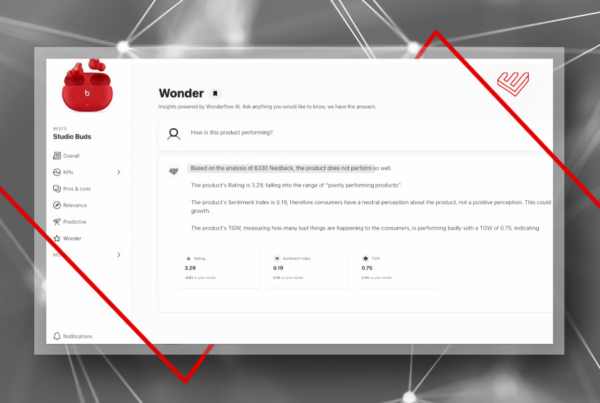Now, if you’re not analyzing your customer feedback to come up with actionable insights, you’ll want to start doing this, ASAP. Going through customer feedback lets you understand your target audience on a deeper, more intimate level; it also allows you to improve upon your product/service to win over more customers.
In this guide, we walk you through all you need to know about analyzing customer feedback with NLP, including:
- Why it’s important to review customer feedback
- The difference between data and actionable insights
- How to transform your data into insights
- Analyzing customer feedback using NLP
- A step-by-step guide to collecting and analyzing customer feedback
Read on to find out more!
Why it’s important to review customer feedback
We’ve briefly discussed how reviewing customer feedback helps you understand your target audience better; that aside, by looking through your customer feedback, you can also pinpoint problems, and solve them before they snowball into full-blown crisis.
For example, say an enterprise software company decides to scale up its support team, and hires 100 more support reps to man its call centre in the Philippines.
Now, this company might not realize that its reps aren’t properly trained, and don’t have sufficient product knowledge to be able to serve customers effectively. If the company routinely analyzes its customer feedback, it’ll quickly realize that there’s an issue, and they can take steps to resolve it. If the company doesn’t analyze its feedback, it would probably be unaware of the issue, until someone writes a scathing review on Facebook that promptly goes viral.
The bottom line? Analyzing your customer feedback can help you identify and nip problems in the bud, and prevent them from escalating. At the end of the day, it’s important to be clued in to whatever your customers are saying about you, so that you won’t be caught unaware when there’s a problem brewing.
The difference between data and actionable insights
This guide revolves around how to analyze customer feedback to generate actionable insights, but before we discuss how exactly to do this, let’s first talk about the difference between data and actionable insights.

Now, don’t make the mistake of equating data to actionable insights, or even insights. Data refers to the quantitative and qualitative output generated from sources such as surveys, while insights refers to takeaways that you get from analyzing your raw data. Then there’s actionable insights, which refer to strategies that can be executed and carried out.
Let’s stick with the same example of the enterprise software company; using this example, we’ll explain the difference between data, insights, and actionable insights:
Data = Product review on G2Crowd: “I was previously using CompetitorName, but their support was abysmal, and I finally decided to switch to CompanyName even though their plan costs slightly more. I definitely made the right choice – CompanyName takes under an hour to respond to emails on average, and I couldn’t be happier with the support they offer.”
Insights = Customers are willing to pay more for a software, as long as they get good support.
Actionable Insights = Instead of offering a cheaper plan, maintain current prices and justify this by offering best-in-class support. Publish average response time and average resolution time on website, and feature these heavily in marketing materials.
How to transform your data into insights
Now that you’re clear on the difference between data and actionable insights, let’s discuss how to analyze your data to come up with these insights.
If you’re looking at quantitative data, this is fairly straightforward. Say that you’re using the Customer Effort Score (CES) to benchmark your customer satisfaction levels, for instance. Because the CES is recorded on a numeric scale (from one to seven), it’s easy for you to track changes in your score, and come up with insights based on any fluctuations.

But with quantitative data, on the other hand, things aren’t as simple. Say you send out a survey, and within that survey, you have a free-text question asking your customers: What do you think CompanyName can improve upon? Obviously, the data that you collect can’t be textured translated into numeric results which are easier to analyze.
Now, if you intend to manually collate and read all the responses, then analyze the content to come up with insights, this will take a lot of time and effort. Here, a workaround is to use Natural Language Processing (NLP) and machine learning (ML) to do the heavy-lifting. These tools analyze qualitative data, and churn out insights that are derived from your customer feedback.

Take Wonderflow. Our tool utilizes NLP to mimic the human ability to comprehend texts. Once you feed your data into the tool, the tool will work to understand the data, and conduct sentiment analysis to gauge whether your customers are satisfied, neutral, or dissatisfied with your product and service.
At the same time, Wonderflow also generates automatic insights based on your customer feedback. You can receive the insights in your inbox in real-time, and these are also made available in Wonderflow’s reports, where the tool shares recommendations on how you can implement your learnings into your product life cycle.
Recently, Wonderflow was selected by independent research firm Aragon Research as one of the companies making an impact in document analytics. Check out the report here.
Analyzing customer feedback using NLP
There are a few ways in which companies can make use of NLP technology to analyze their customer feedback. For instance, companies may look at the frequency of words, word grouping, and sentiment analysis. These strategies all fall under the umbrella category of text analysis.
Frequency of words
In the simplest version of text analytics, topics or terms are counted, and the tool will surface key topics that are mentioned the most frequently.
For example, if your tool tells you that the topic “customer service” comes up frequently in your customer feedback, then you’ll know that this is a major talking point for your customers. Note that this doesn’t let you infer whether your customers are happy or unhappy with your service; it merely tells you that your customers often bring up this specific topic.
Word grouping
With word grouping (also known as word pairing), the text analytics tool looks at the different terms that often occur together.
For example, if you analyze your customer feedback and find that the words “costs”, “affordable” and “cheap” are typically grouped together, this is a good sign that your customers are saying that your product/service is cost-effective, and doesn’t burn a hole in their wallet.
Sentiment analysis
Last but not least, text analysis also includes sentiment analysis. As mentioned earlier, this deals with identifying the underlying sentiment of your customers, and finding out how your customers feel about your product/service. To conduct sentiment analysis, a text analysis tool would look at positive vs negative vs neutral word usage.
What insights can you generate from using NLP to analyze feedback?
The insights that you get largely depends on your inputs (ie the data that you feed into your tool, or the source of your customer feedback).
For example, if you send out a three-question survey to your customers asking them about what they like about your product, what they dislike about your product, and how they think you can improve, then you’ll get insights that revolve around those topics — simple as that.

But if you’re tapping into, say, customer feedback from product reviews, the insights that you generate might be more open-ended — because many customers write lengthy, highly comprehensive reviews.
For instance, the insights that you generate from product reviews might deal with:
- Customers’ pain points
- Customers needs and wants
- Your Unique Selling Proposition (USP) — what makes your product stand out, and what makes customers buy from your brand
- Whether your product lives up to your customers’ expectations
- What your customers are using your product for (use cases)
- How your customers are using your product (frequency, whether it’s used in conjunction with something else, etc)
- What your customers like and dislike about your product
Here’s a screenshot showing how you the type of information you might glean from an Amazon review:
 [/vc_column_text][/vc_column][/vc_row][vc_row type=”in_container” full_screen_row_position=”middle” bg_color=”#f3f2f3″ scene_position=”center” text_color=”dark” text_align=”left” overlay_strength=”0.3″ shape_divider_position=”bottom” bg_image_animation=”none” shape_type=””][vc_column column_padding=”padding-3-percent” column_padding_position=”all” background_color_opacity=”1″ background_hover_color_opacity=”1″ column_link_target=”_self” column_shadow=”none” column_border_radius=”none” width=”1/1″ tablet_width_inherit=”default” tablet_text_alignment=”default” phone_text_alignment=”default” column_border_width=”none” column_border_style=”solid” bg_image_animation=”none”][vc_raw_html]JTNDZGl2JTIwc3R5bGUlM0QlMjJoZWlnaHQlM0ElMjA1cHglM0IlMjBiYWNrZ3JvdW5kLWNvbG9yJTNBJTIwcmVkJTNCJTIwd2lkdGglM0ElMjA1NXB4JTNCJTIyJTNFJTNDJTJGZGl2JTNF[/vc_raw_html][vc_column_text]
[/vc_column_text][/vc_column][/vc_row][vc_row type=”in_container” full_screen_row_position=”middle” bg_color=”#f3f2f3″ scene_position=”center” text_color=”dark” text_align=”left” overlay_strength=”0.3″ shape_divider_position=”bottom” bg_image_animation=”none” shape_type=””][vc_column column_padding=”padding-3-percent” column_padding_position=”all” background_color_opacity=”1″ background_hover_color_opacity=”1″ column_link_target=”_self” column_shadow=”none” column_border_radius=”none” width=”1/1″ tablet_width_inherit=”default” tablet_text_alignment=”default” phone_text_alignment=”default” column_border_width=”none” column_border_style=”solid” bg_image_animation=”none”][vc_raw_html]JTNDZGl2JTIwc3R5bGUlM0QlMjJoZWlnaHQlM0ElMjA1cHglM0IlMjBiYWNrZ3JvdW5kLWNvbG9yJTNBJTIwcmVkJTNCJTIwd2lkdGglM0ElMjA1NXB4JTNCJTIyJTNFJTNDJTJGZGl2JTNF[/vc_raw_html][vc_column_text]
Join hundreds of professionals to learn how you can become more customer-centric.
[/vc_column_text][ninja_form id=”41″][vc_column_text]View our privacy policy for details on use and storage of your personal data[/vc_column_text][/vc_column][/vc_row][vc_row type=”in_container” full_screen_row_position=”middle” scene_position=”center” text_color=”dark” text_align=”left” overlay_strength=”0.3″ shape_divider_position=”bottom” bg_image_animation=”none”][vc_column column_padding=”no-extra-padding” column_padding_position=”all” background_color_opacity=”1″ background_hover_color_opacity=”1″ column_link_target=”_self” column_shadow=”none” column_border_radius=”none” width=”1/1″ tablet_width_inherit=”default” tablet_text_alignment=”default” phone_text_alignment=”default” column_border_width=”none” column_border_style=”solid” bg_image_animation=”none”][vc_column_text]A step-by-step guide to collecting and analyzing customer feedback
Excited to use NLP to generate actionable insights from your feedback? Here’s a step-by-step guide that will help you do just that.
1. Set up a system to collect customer feedback
If you haven’t already done so, go ahead and set up a system (or multiple systems!) to collect customer feedback.
Surveys
Surveys are a quick and easy way of collecting customer feedback. To do this, simply sit down with your team and come up with a list of questions that you’d like to ask, craft a survey, and share the link with your customers.
Pro-tip: make sure that you’re using neutral language (NOT leading questions) in your survey, so that you don’t end up influencing your customer in anyway.
Here’s a positive example: How would you describe your experience with CompanyName?
And a negative example: Have you had a good experience with CompanyName?
Online reviews
As discussed, online reviews are typically data-rich, and they tend to be more comprehensive sources of information than surveys.
Bearing this in mind, come up with a strategy to collect as many product reviews as possible, be it on your independently-run website or on third-party platforms such as Amazon. For instance, you could tweak your shipping confirmation email and include a Call To Action (CTA) that asks for a review (and a review link that your customers to click on).
To go one step further, offer an incentive for customers to review your product, such as free shipping or 20% off their next order.
Social media
If you’ve enabled reviews on, say, your Facebook page, then the reviews that your customers have left you are a great source of customer feedback.
That aside, you can also look at social media posts that bring up your brand — even if your customers are simply posting on their own feeds without tagging you, you could still glean useful insights from these posts.
2. Measure existing customer satisfaction levels
Once you’re done collecting customer feedback, don’t jump straight into analyzing your feedback. Instead, take some time to measure your existing customer satisfaction levels, so that you have a benchmark. If you’ve already done this in the past quarter, then go ahead and skip this step.
3. Organize and interpret data to generate actionable insights
Again, the easiest way to interpret and analyze qualitative data is to use an AI tool such as Wonderflow.
Once you input your data, Wonderflow will use NLG and machine learning to understand your data, and identify key insights. If someone has a question such as, “What is the most negative topic for this product and is it relevant?”, Wonderflow can draw upon the data to offer an answer. Find out more about the solution and technique here.
4. Come up with an action plan and execute it
Now that you’ve identified one or multiple actionable insights, the next step is to come up with an action plan based on the insights. Ideally, your action plan should be multifaceted, and comprise of strategies that your customer service team can work on both in the short and long term. Once that’s done, go ahead and execute the action plan.
5. Track results and measure new customer satisfaction levels
Finally, all that’s left to do is to track your key metrics, and measure your new customer satisfaction levels.
If your customers are significantly happier and more satisfied with their brand experience, then congratulations… you’re on the right track! If your numbers do not improve, or improve only marginally, then take a second look at your insights, tweak your strategies, and try again.
What is consumer feedback and why it is so important to your business
Consumer feedback is a must-have, not a nice-to-have. To learn more about why consumer feedback is important for your business, watch the following video:
If you would like to learn more on this topic, subscribe to Riccardo’s channel here.
[/vc_column_text][/vc_column][/vc_row]Analyzing multi-language customer feedback in large volume from different sources is a complex process. With an AI-based technology and years of experience, Wonderflow is helping global brands to become customer-centric. Find out how companies are working with our solution.






